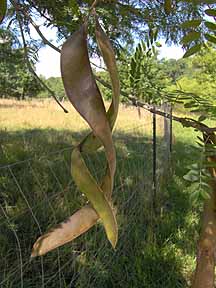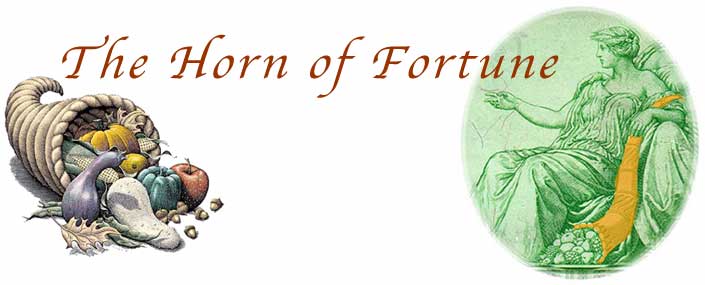

The Corunucopia or “Horn of Plenty” (also called Horn of Amalthea and Harvest Cone): the Horn of Fortune, a great horn or horn-shaped basked, is the moving energy of the Wheel in three (or perhaps more) dimensions. It corresponds to the spiral patterns of actual horns, sea shells, the Milky Way, the inner ear, the DNA double helix, water and atmospheric vortexes, and many other things in the natural world.
In the twenty-first century CE, DNA seems like a significant resonance. Remember, many of Her aspects are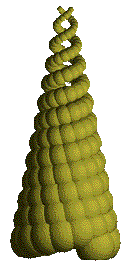 mothers and one is named Fortuna Primagenia; DNA is indeed a “basket” of fine weave, whose abundance is tied to great diversity. It evokes images of whirlpools, tornadoes and cosmic “wormholes”. It is a vortex streaming out of the cosmic heart of Fortuna, and its source is equal to the still center of the Great Wheel. It is linked to
mothers and one is named Fortuna Primagenia; DNA is indeed a “basket” of fine weave, whose abundance is tied to great diversity. It evokes images of whirlpools, tornadoes and cosmic “wormholes”. It is a vortex streaming out of the cosmic heart of Fortuna, and its source is equal to the still center of the Great Wheel. It is linked to  the feminine meaning of the basket, a key fetish in Hellenic Isian religion, a ritual womb clothed in red that stores the fallen grain. It is also linked to the ram’s horn and lightening bolt as symbols of masculine and neutral/raw power respectively. As a horn-shaped basket, the Sacred Cornucopia weds womb and phallus, and so stands as a symbol of balance, fertility, and the Great Rite in which feminine and masculine, Heaven and Earth, achieve actual union. This is the source of all prosperity, material and spiritual. It is the portal of blessing, and the Heavenly Ladder to Greater Union, for there is a Greatest Rite that cannot be accomplished without the Great Rite. The shape and meaning of this basket link Fortuna to other mountain and cave mothers, including Cybele.
the feminine meaning of the basket, a key fetish in Hellenic Isian religion, a ritual womb clothed in red that stores the fallen grain. It is also linked to the ram’s horn and lightening bolt as symbols of masculine and neutral/raw power respectively. As a horn-shaped basket, the Sacred Cornucopia weds womb and phallus, and so stands as a symbol of balance, fertility, and the Great Rite in which feminine and masculine, Heaven and Earth, achieve actual union. This is the source of all prosperity, material and spiritual. It is the portal of blessing, and the Heavenly Ladder to Greater Union, for there is a Greatest Rite that cannot be accomplished without the Great Rite. The shape and meaning of this basket link Fortuna to other mountain and cave mothers, including Cybele.
Magically, one does well to remember that the Horn is a two-way portal with its source in a Divine Person who is compassionate, abundant, and fierce. It is a shamanic gateway, and one of great power: it is present everywhere it is represented, ideal in image, waiting to be used. The Horn can be experienced through visualization. An altar cornucopia (a basket or sculpted one with an empty interior) can be consecrated as a portal; it can also be used as a container for consecrating objects left on the altar or to receive prayers that are written or spoken into it. Magically, the Horn works to deliver prayers and energies to Fortuna’s realm or to broadcast sacred energies. Naturally, one speaks or projects into the large open end to direct energy to Fortuna; one speaks into the point, as with a megaphone, to ritually broadcast. (Remember, “broadcast” is an agricultural term for spreading seed). The Horn is also a cone and corresponds to the cone of energy raised during ritual, the magical Horn of Plenty, a means of communication between the worlds.
It is important, when looking at the attributes of a God/dess, to consider all the symbols together. In most representations, Fortuna has both Wheel and Horn at once. There may be some element of choice involved, but their form reveals that they are parallel attributes that teach convergent mysteries. The Horn always gives, but the Wheel sometimes takes—imagined on the spiral or helix, this malevolent aspect of the Wheel may be the energy that propels us in sometimes disadvantageous directions or in manifestly destructive behaviors. If the Wheel says “Anything can be taken away or restored anew,” the Cornucopia adds, “in any dimension and between dimensions.”
Cornucopia adds, “in any dimension and between dimensions.”
The helicies link her to the spinal serpents of tantra and the rod of Hermes. Because the rising of kundalini results in altered consciousness and because of the messenger status of Hermes/Mercury, this suggests a patterned flow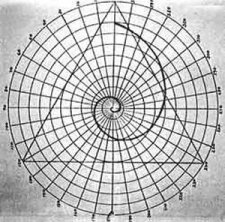 of energy that moves interdimensionally. There is an “energetic” correspondence between wheel and horn, and how the horn amplifies Her teaching about cyclicity and spiritual opportunity. We do not merely repeat the same cycle eternally, but are free to ascend and descend—this is not the face of a clock, but spiraling or helical cyclicity. The pattern may be the same one governing the spiral of the nautilus, one based on the Golden Mean. The Golden Mean corresponds to many unexpected things, like the musical scale, and establishes relationships between Truth and Beauty in physical and abstract structures; it is a signature of the Creators. There is also a strong geometric relationship between the structures of the Cornucopia and the "Spiral of the Adepti" in the Fellowship of Isis, as well as with the coiled serpent atop the Mystery Basket or in Tantric representations.
of energy that moves interdimensionally. There is an “energetic” correspondence between wheel and horn, and how the horn amplifies Her teaching about cyclicity and spiritual opportunity. We do not merely repeat the same cycle eternally, but are free to ascend and descend—this is not the face of a clock, but spiraling or helical cyclicity. The pattern may be the same one governing the spiral of the nautilus, one based on the Golden Mean. The Golden Mean corresponds to many unexpected things, like the musical scale, and establishes relationships between Truth and Beauty in physical and abstract structures; it is a signature of the Creators. There is also a strong geometric relationship between the structures of the Cornucopia and the "Spiral of the Adepti" in the Fellowship of Isis, as well as with the coiled serpent atop the Mystery Basket or in Tantric representations.
The Horn is associated with Greek myth, and these associations would have been present to many Hellenic devotees of the aspects of Fortuna. Amalthea, a being whose name means “tender Goddess” cared for the infant Zeus and is thereby the “Mother of God”. Amalthea was a cave Goddess of Mt. Aigaion. The goat is Her attendant or animal form. Stories about the horn vary, but Amalthea always possesses a magical goat’s horn that supplies abundance. It is interesting to note the shared cave connection with some of the early Roman aspects of Fortuna. Amalthea appears to be a female version of the Pan energies—rural, chthonic, linked to the goat. Amalthea is also linked to the Melissae and sacred bees—A connection I feel the modern Isis-Fortuna shares, for She likes offerings of honey and enjoys bee-inspired ornamentation.
The original 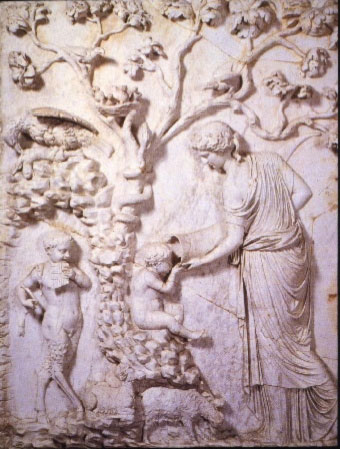 Greek “horn” may have been the drinking vessel known as a rhyton, an inverted cone with an outlet hole in the pointed base. A similar “dripping vessel” was shaped like a breast and carried in Hellenic Isian processions (one is described in Apuleius’s The Golden Ass). It has a modern corollary still made in Greece in the so-called “Pythagoras cup,” a ceramic vessel with a cone in the center that acts to pneumatically drain the whole vessel if it’s overfilled, as by a greedy guest.
Greek “horn” may have been the drinking vessel known as a rhyton, an inverted cone with an outlet hole in the pointed base. A similar “dripping vessel” was shaped like a breast and carried in Hellenic Isian processions (one is described in Apuleius’s The Golden Ass). It has a modern corollary still made in Greece in the so-called “Pythagoras cup,” a ceramic vessel with a cone in the center that acts to pneumatically drain the whole vessel if it’s overfilled, as by a greedy guest.
Zeus was spared from Cronus (sometimes identified with Time) by Amalthea, making it possible for Him to later become the Chief Olympian. He was nourished on Her stuff. The story of Amalthea suggests that our nourishment in nature comes from a spiritual source (indeed, that nature is that spiritual source) and that spiritual realization is accomplished within nature and not apart from it. The “animal” component, however—the unruly goat—must be harnassed and utilized by compassion (Amalthea) and intellect (Zeus) to outgrow time and then to mount Olympus.
In Egypt and some other ancient cultures, bread was baked in ceramic cones. Our word “pyramid” derives from the Greek word for bread of this shape. Egyptian murals of offering tables show not only bread, but other substances shaped or stacked into cones. A great pile of barley suggests not only abundance and survival, but it also mirrors the primal mound of creation and is a visual prayer of thanksgiving to the Creators. In a very palpable way, it acknowledges a connection between present abundance and the most primal moment, a connection that spans time and all the ancestors. This imagery repeats the pairing of cones and abundance and suggests the logic of “heap many blessings.”
The Cornucopia has an Egyptian allomorph in the horns of creator Gods Amun and Khnum, both ram-headed. (Khnum has a Wheel of His own, the potter's wheel that turns with the sound of His name "k-noom, k-noom, k-noom..."). A major cult fetish of Amun is the jet-black specimen of nautilus fossil named in His honor as "ammonite". The basic spiral pattern also corresponds to one glyph for Netjer, Divinity, which is a simple spiral. This linkage of spiral and divinity is also implicit in another glyph for Netjer, ![]() the pennant on a staff (which “unfurls” to make the invisible wind visible, in exactly the same way sacred symbols and sacred stories embody Divine Reality).
the pennant on a staff (which “unfurls” to make the invisible wind visible, in exactly the same way sacred symbols and sacred stories embody Divine Reality).
A shell is a kind of corunucopia of the sea, perhaps linked to Fortuna Navirilis or Fortuna Tranquilla. Shells can be used to calm, in meditation, and to hear oracular voices. Shells can be used for divinatory tokens, a “fortune” inserted and distributed randomly (can also be called unicorn horns; the unicorn may be associated with her or correspond to her.
can be used to calm, in meditation, and to hear oracular voices. Shells can be used for divinatory tokens, a “fortune” inserted and distributed randomly (can also be called unicorn horns; the unicorn may be associated with her or correspond to her.
Other classical Gods who occasionally hold the cornucopia include Gaia, Demeter, Cybele and Hades as Plouton, the bringer of wealth. In the east-west reality of early Buddhism, Hariti was also depicted with the Western cornucopia, and in a style influenced by Hellenic art. In Germanic cultures, rams horns with a wheel or solar disk between them were sometimes placed atop the ritual world-axis poles known as Irminsul. These resemble the capitals of Ionic columns, which also resemble the pattern produced by two oars on the surface of the water.
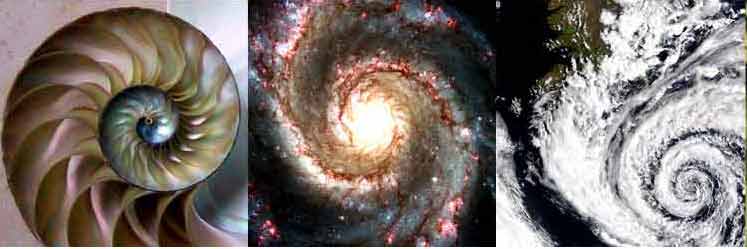
The Horn of Plenty widens, like the axis/rim of the wheel. But if it is double, there is going out and coming in. Is it a funnel or widening gyre?
